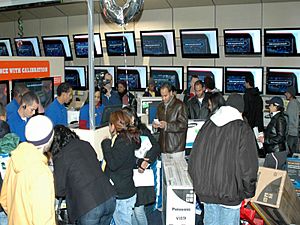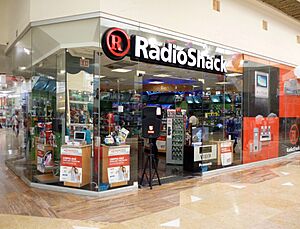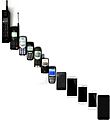Consumer electronics facts for kids
Consumer electronics, also called home electronics, are electronic devices made for everyday use. You'll find them mostly in private homes. Think of your smartphone, TV, or video game console. These gadgets make our lives easier and more fun!
The first big consumer electronic product was the radio. This happened in the early 1900s. After radios, people started using telephones and televisions. Then came calculators, followed by devices to record and play audio and video. Later, video game consoles, personal computers, and MP3 players became popular.
Today, electronics stores sell many different items. These include GPS devices for navigation and car stereos. You can also find video game consoles and digital cameras. Electronic musical instruments like keyboards are also common. Of course, cell phones and smartphones are everywhere.
In recent years, new products have appeared. These include virtual reality headsets. Smart home devices are also popular. They connect things in your home to the internet. For example, you can control lights or thermostats with your phone. Wearable technology, like fitness trackers, is another new trend.
Most consumer electronics today use digital technology. This means they work a lot like computers. In fact, the computer world and consumer electronics are becoming very similar.
Many electronic devices are made to last only a certain time. This is called planned obsolescence. When these devices break or become old, they turn into electronic waste, or E-waste. This waste can be harmful to the environment if not handled properly.
Contents
A Look Back in Time
Electronics have changed a lot over the years.
- In the early 1900s, radios were the main electronic device. People gathered to listen to news and music.
- Later, televisions became popular. They brought pictures and sound right into homes.
- The 1980s and 1990s saw the rise of VCRs. These allowed people to record TV shows.
- Personal computers also started becoming common in homes during this time.
- In the 2000s, DVD players and then Blu-ray players replaced VCRs. Digital cameras also became very popular.
Electronics Today
Today's electronics are often smart and connected.
- Smartphones: These are mini-computers in your pocket. They let you call, text, browse the internet, and play games.
- Video Game Consoles: Devices like PlayStation, Xbox, and Nintendo Switch offer amazing gaming experiences.
- Smart Home Devices: These include smart speakers, smart lights, and smart thermostats. They can be controlled with your voice or phone.
- Wearable Technology: Fitness trackers and smartwatches help you stay healthy and connected.
- Virtual Reality (VR) and Augmented Reality (AR): VR headsets let you explore virtual worlds. AR adds digital information to the real world.
What Happens to Old Electronics?
When electronics break or get old, they become E-waste. This is a growing problem.
- E-waste contains valuable materials like gold and copper.
- It also has harmful chemicals. These can pollute the environment if not disposed of correctly.
- Many companies and organizations now offer recycling programs for electronics.
- Recycling helps protect the planet. It also saves resources by reusing materials.
Images for kids
See also
 In Spanish: Electrónica de consumo para niños
In Spanish: Electrónica de consumo para niños









